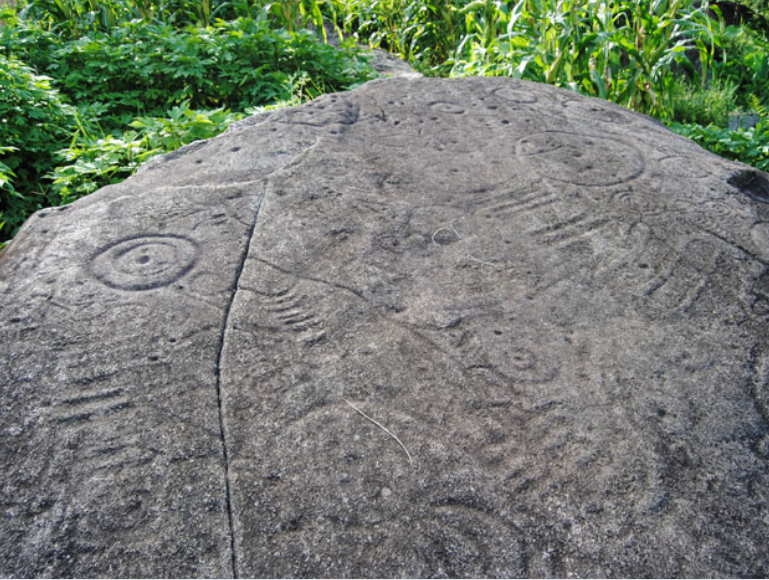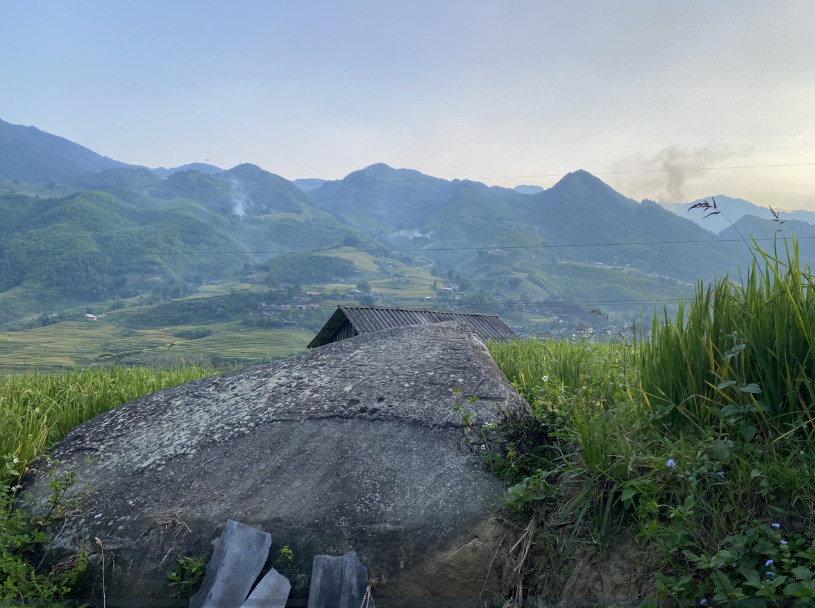1. Overview of Sa Pa Ancient Stone Field
Hidden in the legendary Muong Hoa Valley, the Sa Pa Ancient Stone Field emerges like a history book carved in stone, telling tales of time's mysteries. It is not just an ordinary tourist destination but a bridge between the past and the present, between ancient civilizations and today's world.
1.1. Geographical Location and Natural Context
Nestled within the embrace of mountains nearly 2,000 meters high, the Sa Pa Ancient Stone Field is located in Hau Thao, Su Pan, and Ta Van communes, about 7 km southeast of Sa Pa town center. This prime location creates a stunning natural landscape where ancient stones blend with the green of terraced fields.
The ancient stones are concentrated in two particularly attractive large fields. The stone field near the H'mong people's Pho village impresses with its large boulders, bearing intricate carved patterns. These stone slabs are distributed from the mountainside near the main road, extending down to the poetic Muong Hoa stream.
The second stone field borders Hau Thao and Lao Chai communes, gathering over 100 unique carved stone slabs. They are scattered from the main road, crossing lush green terraced fields up to Hau Chu Ngai village on the mountaintop. The entire Sa Pa Ancient Stone Field spans an impressive area of 8 km², creating a unique open-air museum.
1.2. What Makes This Ancient Stone Field Unique?
In 1994, the Vietnamese Ministry of Culture and Information officially recognized the Sa Pa Ancient Stone Field as a national historical relic – a well-deserved honor for its exceptional archaeological value. This recognition not only affirms the stone field's importance in Vietnam's cultural history but also attracts the attention of the international scientific community.
Over 200 large and small stones here bear diverse and mysterious ancient patterns and symbols that have not been fully deciphered. Each stone slab is a historical puzzle, a piece in the ancient civilization tapestry of the Northwest region. These traces have made the Sa Pa Ancient Stone Field an important archaeological site, attracting tens of thousands of visitors each year to admire and explore.
2. Unique Archaeological Value of Sa Pa Ancient Stone Field
The mysteries of the Sa Pa Ancient Stone Field have been a hot topic among archaeologists for nearly a century. Since its initial discovery, this site continues to be a vivid testament to the development of human civilization in Vietnam's Northwest region.
2.1. Origin of Sa Pa Ancient Stone Field
August 1925 marked a significant milestone when French scholar Victor Goloubev of the École Française d'Extrême-Orient became the first to systematically study the Sa Pa Ancient Stone Field. His research opened up intriguing hypotheses about the origin and age of the stone field.

The ancient stone field can be over 5,000 years old. (Source: Collected)
To date, the scientific community has not yet agreed on the exact era and the owners of these mysterious patterns. Some researchers believe that the Sa Pa ancient stone field belongs to the H'Mong and Dao ethnic communities, dating back about 200-600 years ago. Another hypothesis asserts that this place is associated with the glorious Dong Son culture period, 2,300–3,500 years ago.
There is even a bolder view, suggesting the stone field could be over 5,000 years old, belonging to an ancient civilization not yet fully discovered. The diversity of these views is precisely what makes the Sa Pa ancient stone field more attractive and mysterious than ever.
2.2. Legends about the Sa Pa ancient stone field
Besides scientific research, the Sa Pa ancient stone field is also surrounded by poetic folk legends. According to the elders in the village, the inscriptions on the ancient stones are evidence of the life, beliefs, and sacrificial rituals of their ancestors in the distant past.
Particularly captivating are the legends of the "husband stone" and "wife stone" - these stones carrying sacred meaning associated with the marriage culture and fertility beliefs of the ancients. According to traditional beliefs, these stones symbolize the reproduction and development of the ethnic group and are a place to pray for happy and fulfilling couples.
These stories passed down through generations not only enrich the cultural value of the Sa Pa ancient stone field but also create a special attraction for tourists who want to learn about the soul and spiritual life of the local people.
2.3. Significance of the Sa Pa ancient stone field
For the ethnic communities here, the Sa Pa ancient stone field is not only an archaeological site but also a sacred place containing ancient messages about their origins and identity. These ancient stones preserve the stories of the spiritual life and beliefs of their ancestors, creating a strong connection between the past and the present.
In the process of cultural preservation, the Sa Pa ancient stone field plays the role of vivid evidence of the long-standing cultural history of the Northwest region. This place attracts the attention of international archaeologists, contributing significantly to the cause of preserving and promoting the value of national cultural heritage.
For tourists, the Sa Pa ancient stone field is a special "open-air museum", where they can witness firsthand stones bearing the marks of time. This is a great opportunity to explore the mysteries of the past and immerse oneself in the pristine beauty of the Northwest mountains and forests.
3. Guide to moving to the Sa Pa ancient stone field
The journey to explore the Sa Pa ancient stone field begins with careful travel planning. With many diverse transportation options, visitors can easily find suitable methods for their budget and time.
3.1. Moving from Hanoi/Saigon to Sa Pa
Departing from the capital Hanoi, visitors have three popular options to reach Sa Pa. The Hanoi - Lao Cai train route offers a romantic experience with a travel time of about 8-9 hours. Ticket prices range from 250,000 - 600,000 VND depending on the type of seat or sleeper you choose. This is a great way to enjoy the countryside scenery and relax throughout the journey.
Buses and limousines are faster options with a travel time of 5 - 6 hours. Reputable companies like Sapa Express, Inter Bus Lines offer quality services with an average price of 250,000 - 450,000 VND. These modern, comfortable vehicles will take you through beautiful winding mountain roads.
For those who love freedom, self-driving via the Noi Bai - Lao Cai expressway is an ideal choice. A 5–6 hour journey with fuel and toll costs around 600,000 - 1,000,000 VND allows you to stop at any point you wish.
Visitors from Saigon can fly to Hanoi or Noi Bai Airport, then continue their journey to Sa Pa using the options above.
3.2. How to get to the ancient stone field from Sa Pa center
Once in Sa Pa, getting to the Sa Pa ancient stone field becomes simple with a distance of 7–8 km to the southeast along the road down to Muong Hoa valley. This road offers stunning visual experiences with terraced fields and traditional villages.
Motorbikes and bicycles allow you to control your time, freely stop for photos, and experience the winding mountain roads. This is also the best way to fully appreciate the beauty of the Northwest mountains. Taxis and motorbike taxis are suitable for families with young children or tourists not accustomed to driving on mountain roads.
Especially, trekking is an option for those who love exploration and adventure. You can combine a visit to the Sa Pa ancient stone field with attractions such as Sun World Fansipan Legend, Cat Cat village, or Lao Chai in the same trip, creating a diverse and rich travel experience.
4. Top experiences when visiting the Sa Pa ancient stone field
Every step taken on the Sa Pa ancient stone field brings unforgettable experiences. This place is not just a tourist spot but also a journey to explore the mysteries of time and space.
4.1. Learning about the history of the stone field
The exploration journey begins with learning about the research process of the Sa Pa ancient stone field from 1925 to the present. The important discoveries by archaeologists over nearly a century have gradually revealed the mysteries about the owners and significance of the stone field. Visitors will hear about interesting hypotheses, from the glorious Dong Son culture to ethnic minority communities.

Visitors can hear the story of the ancient stone field. (Source: Collected)
Each piece of information shared carries high scientific value, helping visitors understand more about the importance of the Sa Pa ancient stone field in the history of the local people. This is what makes the visit more meaningful and profound than ordinary tourist destinations.
4.2. Touch and feel the unique patterns on the stones
The first sensation when placing your hand on the surface of the ancient stones is a shiver from the power of time. The patterns deeply carved on the stone surfaces bear many unique shapes: human figures, mysterious spirals, ancient valley maps, and even undeciphered square characters.
Each carving is done with exquisite craftsmanship, demonstrating the high skill level of ancient artisans. When touching the stone surface, you can clearly feel the depth and precision of each line, as if directly conversing with skilled craftsmen from thousands of years ago.
This experience brings a unique sense of connection between the present and the past, helping visitors understand more deeply the artistic and cultural values that the Sa Pa Ancient Stone Field preserves.
4.3. Conquer the entire Sa Pa ancient stone field
With over 200 stones scattered across a vast area of 8 km², exploring the entire Sa Pa ancient stone field is an exciting challenge for adventurous tourists. The stones are not clustered but "hidden" everywhere: in terraced rice fields, on mountainsides, or by the Muong Hoa stream.
Each stone is an unsolved mystery, carrying its own unique stories. Moving between different areas not only brings a sense of conquest but also allows visitors to admire the diverse and beautiful natural scenery of the Muong Hoa valley. This journey requires good physical strength and perseverance, but in return, it will bring the most memorable experiences and discoveries during your trip to the Sa Pa ancient stone field .
4.4. Check-in at the father stone - mother stone, husband stone - wife stone
The stone formations called by locals as "father stone", "mother stone", "husband stone", and "wife stone" not only hold deep spiritual cultural value but are also attractive check-in spots at the Sa Pa ancient stone field . These stones are associated with the cultural life and beliefs of ethnic communities, symbolizing family unity and eternal love.
The special locations of these stones create beautiful photo opportunities with the Muong Hoa valley and majestic mountains as the backdrop. Many couples have chosen this place to capture romantic moments, believing that the sacredness of the stones will bless their love.
Besides their photographic value, learning about the cultural significance of each stone also helps visitors gain a deeper understanding of the soul and worldview of the local people.
4.5. Other experiences for relaxation
The Sa Pa ancient stone field offers an ideal relaxing space amidst the nature of the Northwest mountains. The fresh air of the green meadows creates a refreshing feeling, helping visitors temporarily forget the hustle and bustle of daily life. The sound of wind blowing through the leaves and the babbling of streams create a gentle natural melody.
From the Sa Pa ancient stone field , visitors can admire the panoramic view of the winding terraced rice fields like green silk ribbons stretching to the horizon. During the water-flooding season, the fields reflect sunlight, creating shimmering, picturesque scenes. The golden ripe rice season brings warm, vibrant colors.
Quiet moments by the ancient stones, listening to the stories of time and feeling the pulse of history are precious spiritual gifts that the Sa Pa ancient stone field offers to every visitor.
5. Visit nearby tourist attractions to the Sa Pa ancient stone field
The convenient location of the Sa Pa ancient stone field allows visitors to combine exploring many other attractive destinations in a single trip. This diversity creates a rich and memorable travel experience.
5.1. Sun World Fansipan Legend
Not far from the Sa Pa ancient stone field , Sun World Fansipan Legend stands as a symbol of modern Sa Pa tourism. The world's most advanced three-rope cable car system takes visitors to conquer Fansipan, the "Roof of Indochina," at 3,143 m in just 15 minutes, instead of 2-3 days of trekking as before.
Here, the spiritual complex of Trinh Pagoda with its classic Vietnamese architecture creates a serene space amidst the mountains. Highland cultural festivals held year-round offer opportunities to learn about the life and traditions of the Northwest ethnic groups. The square at the summit of Fansipan is an unmissable check-in spot with a 360-degree view of the majestic Hoang Lien Son mountain range.
Combining a visit to the Sa Pa ancient stone field - a repository of past traces - with Sun World Fansipan Legend - a symbol of modernity - creates a travel journey balanced between tradition and the present.
5.2. May Bridge (Ta Van)
This rustic bridge made from rattan vines is a testament to the ingenuity and intelligence of the local people. The May Bridge spans the poetic Muong Hoa stream, creating an ideal stopping point on the way from the Sa Pa ancient stone field to nearby villages.
The pleasant babbling of flowing water combined with the swaying steps on the bridge creates an interesting and memorable experience. Visitors can stop to take photos with the beautiful natural scenery and hear stories about the traditional construction of rattan bridges by the highland ethnic groups.
The bridge is not only a means of transportation but also a cultural symbol, demonstrating the harmony between humans and nature in the worldview of the Northwest people.
5.3. Lao Chai Village
Nestled between the majestic Hoang Lien Son range and Ham Rong mountain, Lao Chai village is a beautiful settlement that preserves rich traditional cultural identity. This is home to the H'Mong and Dao communities, who have been connected to this land for generations.
Traditional wooden stilt houses are nestled amidst terraced fields, creating a peaceful and poetic scene. Visitors have the opportunity to learn about the daily life and traditional crafts such as weaving, rice cultivation, and animal husbandry of the ethnic people.
Combining a visit to the Sa Pa ancient stone field - a repository of ancient traces - with Lao Chai village - where traditional culture is still maintained today - provides a comprehensive view of the history and culture of the Northwest region.
6. Notes when visiting the Sa Pa ancient stone field
To ensure the best experience and contribute to protecting this precious heritage, visitors should note some important points when visiting the Sa Pa ancient stone field .
Visitors must absolutely not climb, carve, draw, or leave any marks on the ancient stones. These seemingly small actions can cause irreparable damage to the nation's precious cultural heritage.

Protecting historical sites is the responsibility of every tourist. (Source: Collected)
When interacting with local people, show respect for their culture and traditions. Always ask for permission before taking photos of people, especially children and the elderly. Politeness and friendliness will help you have meaningful cultural exchange experiences.
Clothing suitable for rocky terrain and terraced fields is essential. Sports shoes with non-slip soles will help you move safely on potentially wet rocky slabs. Wear comfortable clothes, bring a hat and sunscreen to protect your skin from the effects of the highland weather.
The ideal times to visit are early morning from 7-9 AM or late afternoon from 3-5 PM when the soft light creates the best photo opportunities. This time is also cooler, convenient for moving and exploring. The best photo spots at ancient stone field of Sa Pa (Bai da co Sa Pa) include large rocks near Muong Hoa stream (Muong Hoa), with terraced fields as a backdrop, and high points with panoramic views of the valley.
The ancient stone field of Sa Pa (Bai da co Sa Pa) is not only a unique tourist destination but also a bridge between the past and the present, between historical mysteries and the natural beauty of the Northwest. 2025 is an ideal time to explore this cultural treasure with increasingly complete tourism infrastructure and better support services. Come and feel the magic of time carved in stone in the legendary Muong Hoa valley (Muong Hoa)!



